Alocasia (Elephant's Ear): Care Features
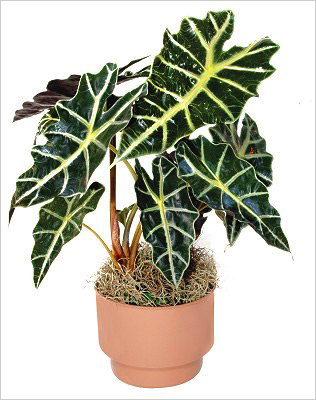
Alocasia is a tropical plant with large leaves of various shapes and colors. It belongs to the aroid family and encompasses over fifty species. All Alocasias share distinctive features such as dense, shield-shaped, oval leaves with pointed tips and prominent veins.
Alocasias known as "elephant ears" or "three-leaved plants." The hybrid Alocasia × amazonica has gained the Royal Horticultural Society's Award of Garden Merit. This tropical beauty also goes by common names African Mask and Polly Plant. A. x amazonica 'Polly' is a popular cultivar that stays compact.
Alocasias grow from rhizomes, which can be divided in spring for more plants. Each rhizome produces several leaves that grow to 1 ft (30) long.

Originating from the tropical forests of Southeast Asia, particularly Malaysia and Ceylon, Alocasia exhibits a unique behavior during the rainy season. Unable to absorb all the water in the soil, its leaves start "crying." In domestic settings, excessive watering and humidity can also prompt Alocasia to release water droplets. Since humidity rises before rain, some consider the Alocasia a natural rain predictor.
As indoor plants, only a few varieties are cultivated, distinguished by leaf shape, size, color, and overall height. Some can grow up to 1 meter (3 meters in the wild).
These exotic tropical wonders are rightfully recognized as one of the most splendid foliage plants. Alocasias enhance interiors, especially in bright halls, foyers, winter gardens, and near artificial water features and fountains.
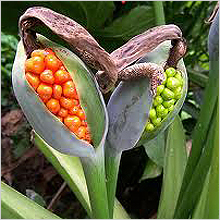
Alocasia rarely blooms. Its fragrant, small, pale-colored flowers form in a white-pink inflorescence partially covered by a protective leaf-like bract. Removing flowers is recommended as blooming inhibits leaf growth, and the true beauty of this decorative foliage lies in its leaves. Cut surfaces should be treated with crushed charcoal.
All parts of Alocasia are toxic, with the plant sap possessing irritant properties. It is advised to keep Alocasia out of reach of children and pets.
Usage
Alocasia odora, known for its aromatic qualities, is used in traditional Chinese medicine. Extracts from the stem are employed for stomach and dental pain, while leaf-based preparations are used in treating pneumonia and tuberculosis. However, due to Alocasia's toxic nature, experimentation with its medicinal applications is discouraged.
Some Alocasia varieties are cultivated for their edible tubers, which are rich in starch.
Types of Alocasia
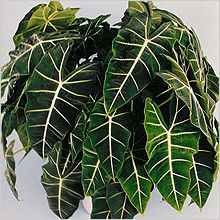

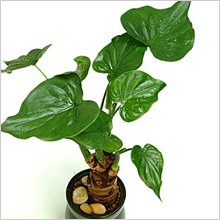
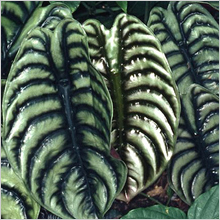
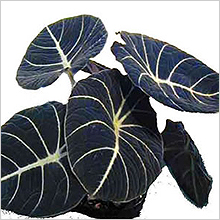
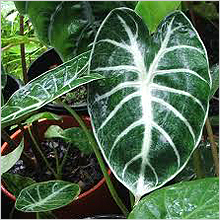
Caring for Elephant's Ear (Alocasia)
Alocasia is thrives in a warm and humid microclimate, providing conditions close to its natural habitat for this tropical beauty to flourish.
If you ensure conditions similar to its natural environment, your tropical beauty will delight you with its exotic charm. Occasional yellowing and shedding of leaves on Alocasia, one at a time rather than all at once, is a normal process as new growth replaces the lost foliage.
Light: Alocasia prefers bright light, but during summer, it should be shielded from direct sunlight. Some varieties, especially Alocasia cuprea and Alocasia amazonica, may require additional lighting in winter.
Temperature: Being heat-loving, Alocasia dislikes temperature fluctuations and should never be placed in drafts. Average to warm 65-75°F/18-24°C.
Humidity: Alocasia prefers high humidity, and during hot weather, it benefits from occasional misting. To increase humidity, placing the plant on a tray filled with damp clay pebbles or gravel can be effective. In winter use a cool-mist room humidifier near the plant for best results.
Water: Keep soil moist spring through fall when plant is actively growing. Water sparingly in winter, allowing soil to become almost dry between waterings.
Fertilizer: Alocasia requires regular feeding in spring and summer, approximately every 2-3 weeks. It is advisable to use a complete mineral fertilizer for indoor plants.
Repotting: The soil for Alocasia should be nutrient-rich, well-draining, and slightly acidic (pH around 5.5). Repotting is recommended annually, usually in early spring, and every two years for mature plants. A suitable soil mix consists of 1 part leafy soil, 1 part coniferous soil, 1 part peat, and 0.5 parts sand. For larger specimens, repotting can be substituted with transferring to a larger pot with good drainage.
Propagation: Alocasia can be propagated through various methods, including seeds, division of rhizomes, offsets, or stem cuttings. Varieties with variegated leaves cannot be propagated reliably from seeds. When sowing seeds immediately after harvesting, use a light substrate (leaf or peat soil and sand), cover with glass or film for high humidity, maintain a temperature of 22-24°C, and water regularly. Transplant the seedlings after germination, and large leaves will appear within a year.
Propagation through offsets or tubers is simpler. When dividing rhizomes or preparing stem cuttings, remember to cover cut areas with wood charcoal. The same substrate used for seed sowing is suitable for rooting. Cover planted cuttings with plastic film for successful rooting.
Pests and Diseases: Common pests affecting Alocasia include aphids and spider mites, with potential infestations by mealybugs and scale insects. Dry air and high temperatures contribute to pest problems. If pests are detected early, gently wipe leaves and stems with a soapy sponge. For severe infestations, apply a solution of actellic (1-2 ml per liter of water) or a similar remedy.




